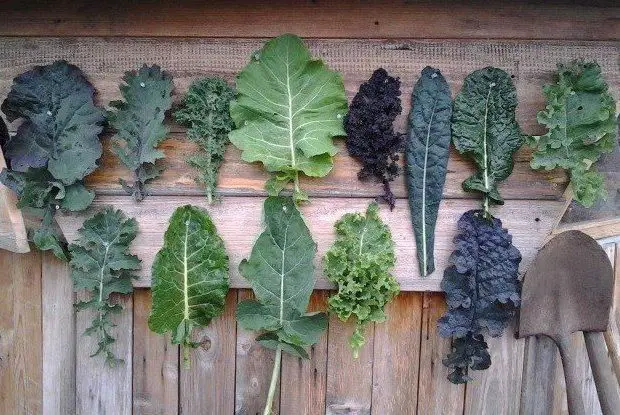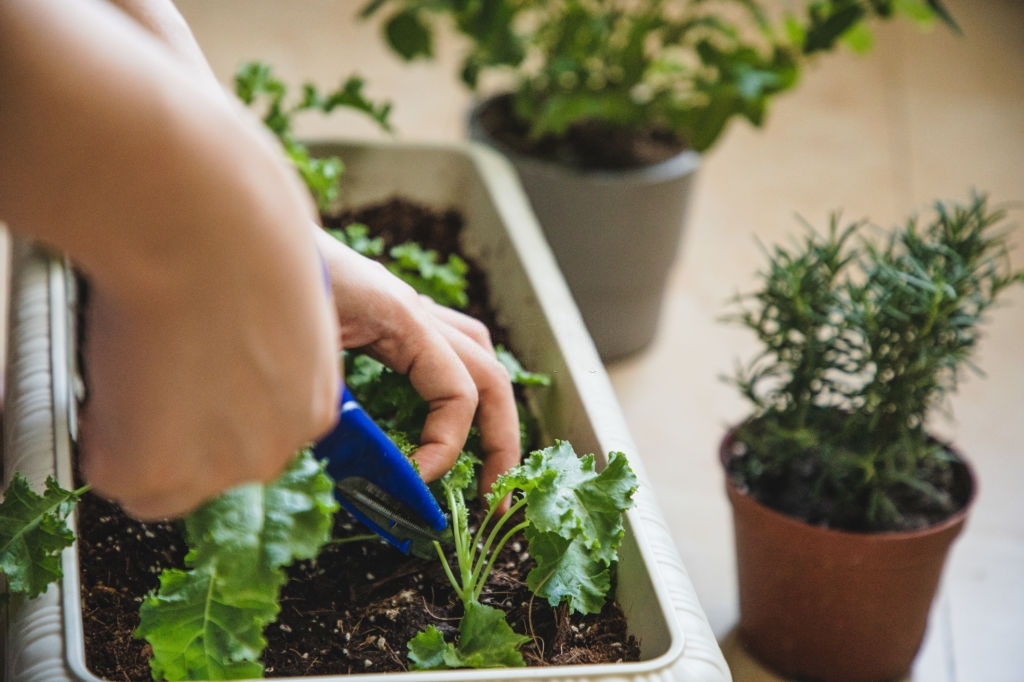Kale is one of the most beneficial plants you can grow in your homestead garden. Besides the high fiber content, kale is naturally rich in iron, calcium, vitamin C, magnesium, potassium, and beta-carotene.
Kale is easy to grow, cold-resistant, and goes from seed to harvest in only two months. In no time, you’ll have enough leafy goodness to add to smoothies, soups, pasta, and stir-fries. You can even bake a few leaves into kale chips for a tasty and nutritious snack.
Types of Kale
Kale’s scientific name is Brassica oleracia. Other plants in the Brassica family include broccoli, cabbage, cauliflower, kohlrabi, and Brussels sprouts. Kale is a biennial plant that most gardeners grow as an annual. However, you can allow kale to continue to grow for more than one season if you live in a warmer climate. The leaves will die back in the winter and regrow in the spring.

Kale comes in several forms, including curly varieties like Vate’s Blue and narrower subspecies like Lacinato or Dinosaur kale. Some types of kale like Redbor and Red Russian feature colorful aspects like red veins, bluish leaves, and purple hues.
Covolo Near kale has unusual slate-gray leaves and grows particularly well in the northern part of the US and Europe. You can also grow dwarf varieties if you have a smaller garden. If you can’t decide which type of kale to plant, you can buy seed packs that include several varieties.
Growing Kale from Seed
You’ll want to sow kale seeds in late winter or early spring as kale plants prefer temperatures between 55 and 75℉. Most gardeners choose to sow seeds around ½ inch deep and around 18 inches apart. The seeds are tiny and can easily wash away, so it’s best to use a spray bottle with a light mist to keep the soil moist. Kale seeds typically germinate in 7 to 10 days.
You can also start kale seeds indoors in seedling starter trays or small individual pots. Apartment dwellers may even want to grow kale completely indoors near a sunny, south-facing window or under fluorescent or LED grow lights. All you’ll need are a couple of 12” pots and a few bags of well-draining potting soil. Make sure your plants get 4-6 hours of sunlight per day, fertilize them every few weeks, and you can harvest kale all year long.
Planting Kale Seedlings
Kale grows equally well in containers, raised beds, and well-prepared garden soil. With its interesting colors and textures, kale also makes a nice compliment to ornamental plants in containers. When kale is left to grow for more than one season, the plants produce edible yellow blooms, and you can use the seeds for your next crop.
You’ll need to be especially careful when transplanting kale seedlings as the roots are on the fragile side. Gardeners should make sure the soil is rich in nutrients but well-drained. Many experts recommend adding lime to garden beds or containers about three weeks before planting kale seeds.
Unless you’re planning to harvest all your kale in the baby green stage, you’ll want to place seedlings at least 1.5 feet apart. Kale plants are excellent for herb gardens and do exceptionally well when located near aromatics like chamomile, garlic, sage, chives, and rosemary. However, companion planting near tomatoes or peppers isn’t a good idea as the soil these plants like is too acidic for kale.
Caring for Kale Plants
You’ll have to provide shade for kale if you live in a particularly hot and dry climate. Kale plants like somewhat acidic soil, and you can check the pH using a standard soil pH kit. Additionally, kale loves nitrogen, so you’ll need to periodically add a thin layer of nitrogen-rich organic compost.
Kale plants perform best with a constant level of moisture. However, gardeners should make sure to keep the soil moist without flooding it. Evenly wet soil will produce crisp and sweet leaves, while an uneven or inadequate water supply will lead to tough leaves with a bitter aftertaste. Adding a layer of organic mulch will help you maintain consistent moisture levels.
While kale plants require at least four hours of sunlight per day, they won’t tolerate scorching-hot direct sunlight during the summer or in subtropical climates. You’ll need to protect your plants by either covering them or moving them out of direct sunlight during the hottest part of the day.
On the other end of the spectrum, you won’t need to worry about unseasonably cold days with kale plants. The leaves become sweeter and tastier after being exposed to a light frost.
First-Aid for Kale Pests and Diseases
Cabbage worms are the arch enemies of kale plants. These little devils are actually moth caterpillars, and they can quickly infest and ruin an entire kale crop in the blink of an eye. Kale is also susceptible to aphids, flea beetles, and cabbage loopers.
You can keep infestations under control by spraying your plants with neem oil in the evenings or populating your garden with helpful insects like ladybugs, praying mantis, or parasitic wasps.
Another way to protect your garden is to cover your kale and other Brassica family plants with floating row cover. Row cover is a lightweight, inexpensive material that works particularly well for raised beds. Covering kale plants will also protect them from hungry grasshoppers who gorge on almost anything with leaves.
Larger predators like groundhogs and pigeons also love to munch on kale. The birds can be deterred with overhead netting, but groundhogs are another story since they burrow in from the bottom. If you have a groundhog problem, you may want to grow your kale in pots on the patio, or you might end up obsessed like Bill Murray in that old movie Caddyshack.
Harvesting Kale
Harvest kale as you go, like lettuce, arugula, and other leafy greens, by snipping off the outer leaves near the root. You can start harvesting kale in the baby stage around 25 days after sowing the seeds. The leaves make excellent additions to salads while they’re still small.
You can let the inner leaves continue growing to add to main dishes. After about five weeks, your unharvested kale leaves will be about eight inches tall.
Growing Kale Highlights:
| Seed Depth | ½ inch |
| Mature Height | 1-2 feet |
| Climate | Cooler |
| Light | Sun to partial sun |
| Soil | Moist and rich yet well-drained |
| pH | 6.5 to 6.8 |
| US Zones | 7-9 |


